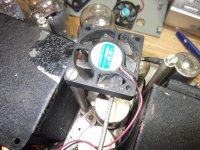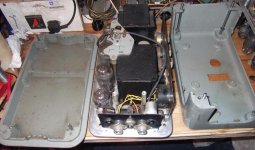make the fan blow.
make the fan suck cold air from the bottom.
Make the sink vertical, so that warmed air exits at the top.
This ensures the "chimney effect" is working to help the fan.
It allows the fan to run slower for less noise and less consumption. The fan may not be needed for some operation.
AND
make sure there is no obstruction to flow at the inlet to the fan !!!!!!
make the fan suck cold air from the bottom.
Make the sink vertical, so that warmed air exits at the top.
This ensures the "chimney effect" is working to help the fan.
It allows the fan to run slower for less noise and less consumption. The fan may not be needed for some operation.
AND
make sure there is no obstruction to flow at the inlet to the fan !!!!!!
make the fan blow.
make the fan suck cold air from the bottom.
Make the sink vertical, so that warmed air exits at the top.
This ensures the "chimney effect" is working to help the fan.
It allows the fan to run slower for less noise and less consumption. The fan may not be needed for some operation.
AND
make sure there is no obstruction to flow at the inlet to the fan !!!!!!
The "no obstruction" is a very good point. In industrial applications the rule of thumb is a fan requires whatever it's diameter is for open space to feed it, a 4" diameter fan would require 4" of open space to feed it. This is obviously impossible in many audio applications but it's something to keep in mind.
thanks for the replies gentleman.
this is something that i've pondered about for a long time and now want to research to confirm if there is any difference between forcing air into or out of an enclosure with respect to cooling.
in my early years as a touring soundtech i was preached by my superiors that exhausting heat from a rack of amps was better than trying to push air into a heated enclosure.(one anecdote that was repeated like a mantra was "when a blacksmith wants to get a piece of metal hotter he blows air on it" i was and still am not sure if this is indeed correct)
as a service tech i will say that amps or racks of gear in which fans are exhausting warm air seem to accumulate less dust and debris which can be significant in terms of cooling.
this is something that i've pondered about for a long time and now want to research to confirm if there is any difference between forcing air into or out of an enclosure with respect to cooling.
in my early years as a touring soundtech i was preached by my superiors that exhausting heat from a rack of amps was better than trying to push air into a heated enclosure.(one anecdote that was repeated like a mantra was "when a blacksmith wants to get a piece of metal hotter he blows air on it" i was and still am not sure if this is indeed correct)
as a service tech i will say that amps or racks of gear in which fans are exhausting warm air seem to accumulate less dust and debris which can be significant in terms of cooling.
(one anecdote that was repeated like a mantra was "when a blacksmith wants to get a piece of metal hotter he blows air on it" i was and still am not sure if this is indeed correct)
When a blacksmith wants to get metal hotter, he blows air through the burning coal in his forge and the extra oxygen supply makes the coal burn hotter. An audio amplifier hopefully doesn't contain burning fuel so this is completely irrelevant.
For some geometries of air vent holes, the resistance to flow can depend on the direction of flow. When air is being sucked into a hole, it will go in easier if the hole has rounded edges, but when it is being blown out the shape of the edges doesn't matter.
this is something that i've pondered about for a long time and now want to research to confirm if there is any
difference between forcing air into or out of an enclosure with respect to cooling.
The fans will certainly last longer if they pull in cool air, rather than draw out hot air.
well i guess that i'll have to experiment/wrestle with this question further.i've yet to find any info or research either confirming or refuting this. (one is better than the other)
scopeboy i thought the same way when i heard the"blacksmith" mantra which is why i was always puzzled by whether the statement was correct.
scopeboy i thought the same way when i heard the"blacksmith" mantra which is why i was always puzzled by whether the statement was correct.
Last edited:
The old fashioned engine driven fans in automobiles wasted power because they sucked through the radiator.
As soon as we went to electric driven cooling fans, the manufacturers moved the fans to the other side from the engine so that they blew through the radiator.
In the original mini the fan blew through the radiator which was located in the side wing.
The imp also blew through the radiator even though it blew from back to front and exhausted out under the car.
Blowing is more efficient.
As soon as we went to electric driven cooling fans, the manufacturers moved the fans to the other side from the engine so that they blew through the radiator.
In the original mini the fan blew through the radiator which was located in the side wing.
The imp also blew through the radiator even though it blew from back to front and exhausted out under the car.
Blowing is more efficient.
The old fashioned engine driven fans in automobiles wasted power because they sucked through the radiator.
As soon as we went to electric driven cooling fans, the manufacturers moved the fans to the other side from the engine so that they blew through the radiator.
My last 2 cars have had pusher and puller fans. Thermo fan engine driven off the alternator pulley and electric pushing through. Its 10 years old but hardly old fashioned.
Generally suck is better than blow to get heat out as blowing can cause problems with cooling as you don't always get a nice laminar flow. For a project amp generally not an issue of course.
My car has an electric fan mounted behind the radiator on the engine side, that presumably sucks air through.
Usually car cooling fan placement is selected by available space and serviceability more than efficiency.
Servicability? I've never had an electric fan fail on me. Mind you not had a viscous fail either. Given how unservicable the parts that do fail on cars is I find your argument hard to believe. If you had said ' saves 4 seconds in initial assembly' I WOULD believe you.
The 4 seconds on assembly likely plays into it as well on mass produced vehicles. Either way efficiency isn't the first concern. On the vehicles I build I think about serviceability on every part. I worry about efficiency of the fan position less. I can always use a higher flow fan and vary the speed as needed. But these are 1 off customs.
Viscous fans used to be a bit of a problem in North American vehicles. They used to lock on and stop the car from warming up. They sounded like an airplane then too.
Last edited:
The 4 seconds on assembly likely plays into it as well on mass produced vehicles. Either way efficiency isn't the first concern. On the vehicle I build I think about serviceability on every part. I worry about efficiency of the fan position less. I can always use a higher flow fan and vary the speed as needed. But these are 1 off customs.
I beg to differ. The only reason my car has a viscous fan is because it needs it to support the full range of expected use cases. A viscous fan costs more and saps more HP than an electric. VAG do not waste money. Try and add a penny to the cost of a part you sell an auto vendor!. They put that fan in to shift lots of air when towing up a mountain with 5 people and luggage on board.
I've built cars too
I fitted fans to my vintage mono block amplifiers and these relied on a little bit of suction from the cinema projector that was once up on a time mounted on the top of the cast cabinets through a small cut out that also carried wiring for the lamp and motor. The only place the fan could go was below this cutout.
I removed the bracket with the notes marked on it and replaced the input cable to make the space for the fan to fit onto the mounting point that the bracket was screwed to.
There was little choice about sucking or blowing the air. It was all down to the internal layout of the equipment for me.
I removed the bracket with the notes marked on it and replaced the input cable to make the space for the fan to fit onto the mounting point that the bracket was screwed to.
There was little choice about sucking or blowing the air. It was all down to the internal layout of the equipment for me.
Attachments
not really. Just depends on your application. If you want to stir the air around a bit, which is all most want, then suck or blow will do that, with suck giving a more even 'stirring'. If you want to cool something hot (as in forced cooling) then suck is still better unless you have a heatsink for that purpose which causes turbulence in the airstream. Oh and slower fan speeds are often better unless you really need the CFM.
If you are trying to get a 100W class A amp into a shoebox, then you need to do your research.
If you are trying to get a 100W class A amp into a shoebox, then you need to do your research.
i'm just trying to find out if either approach (in /out) has any advantage/disadvantage with respect to cooling.
At the end of the day you are just trying to get air flow. A pusher fan is supposed to move air more efficiently. The hard part is getting the air to move where you want it to. That is more easily done by pulling the air usually, but not always. Puller fans have the issue of being in warmer air all the time so they may fail sooner. A small increase in fan diameter usually has a huge increase in air flow so they can be run at lower rpm, lowering noise levels at the same time. Another possibility in improved cooling methods might be liquid cooling. Being able to bring all the heat to a central location to be dealt with would make the actual cooling process easier if the pumping systems required aren't a new nightmare in itself. It seems to be working well in computers.
- Status
- This old topic is closed. If you want to reopen this topic, contact a moderator using the "Report Post" button.
- Home
- Design & Build
- Construction Tips
- fan cooling

